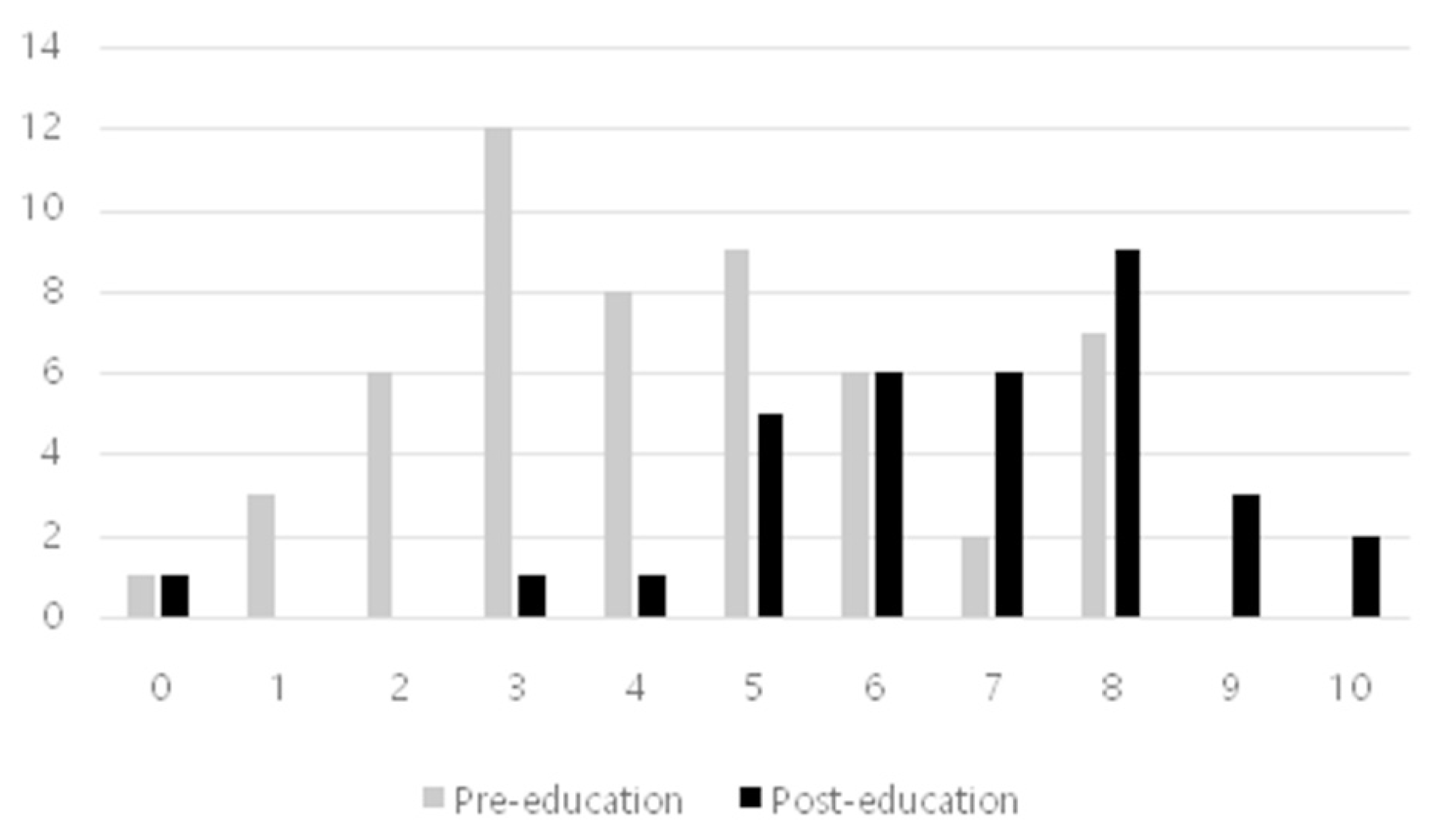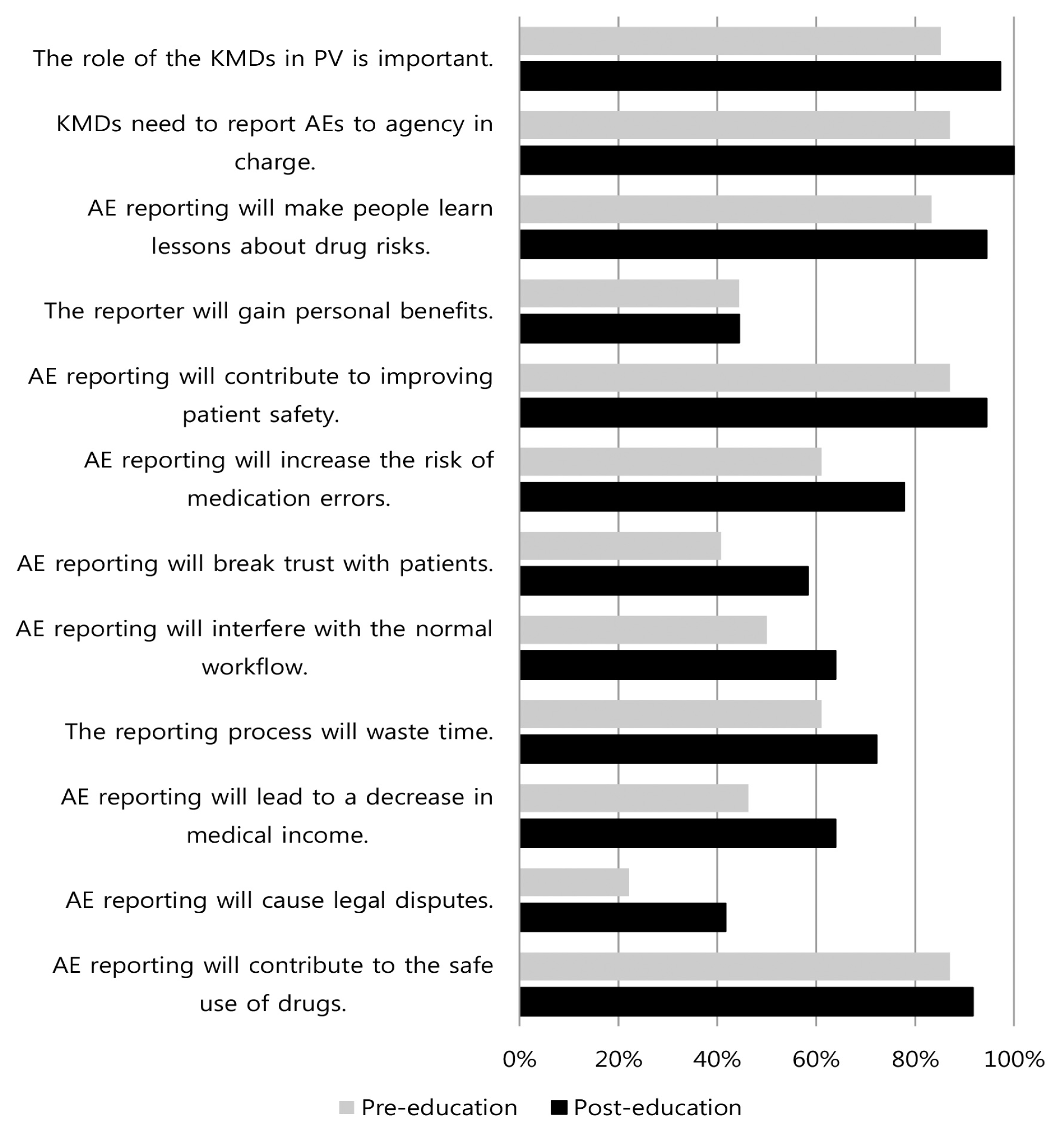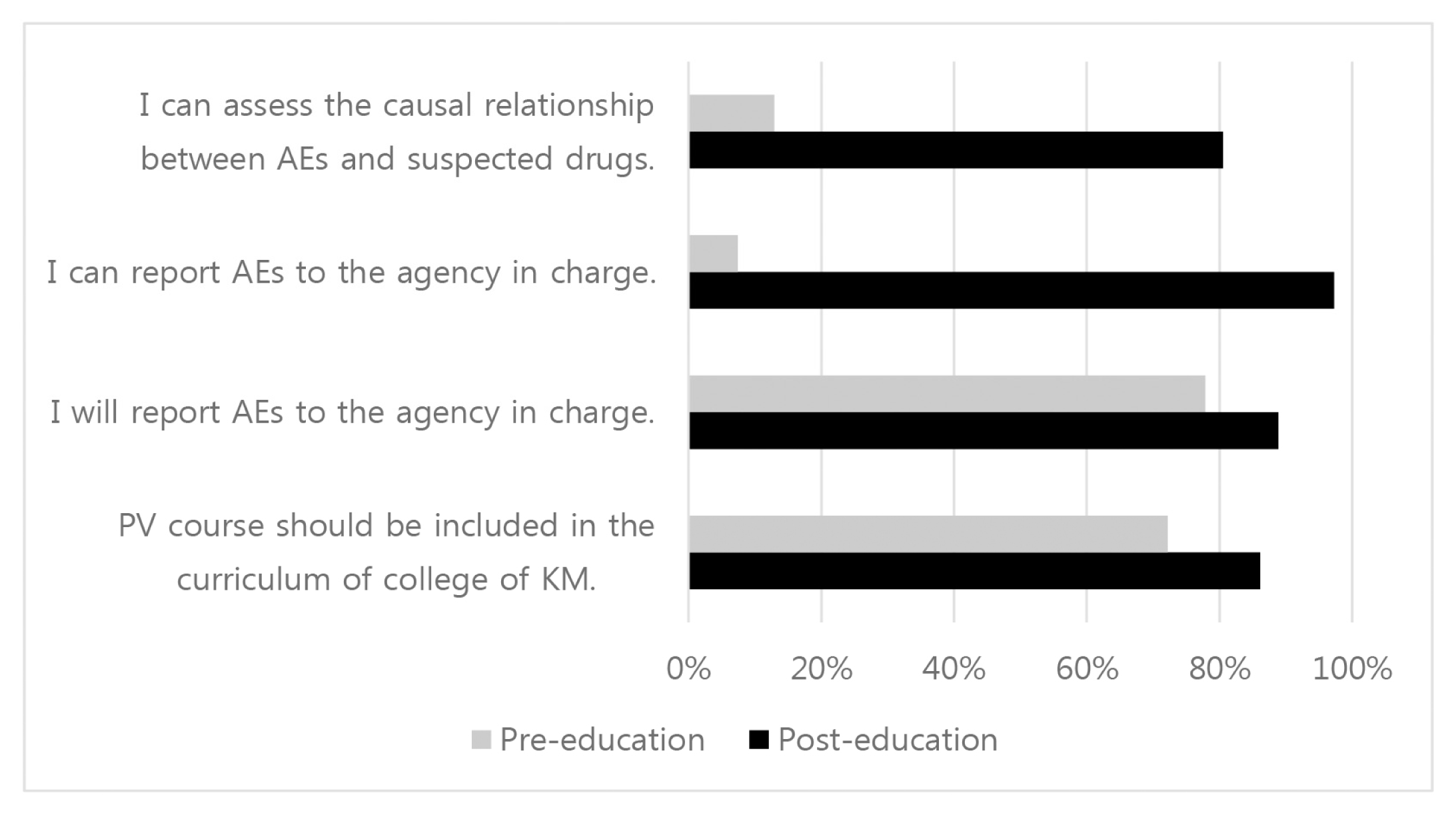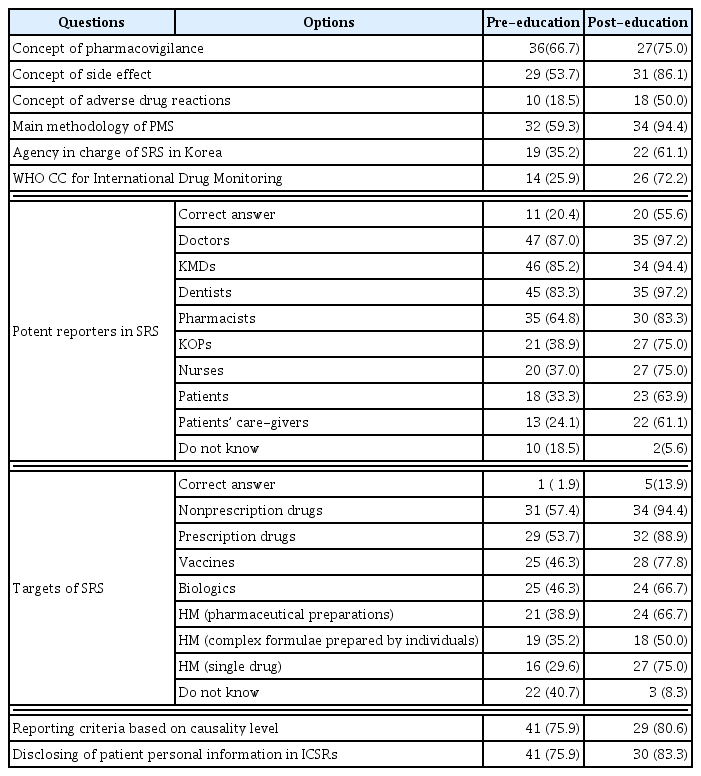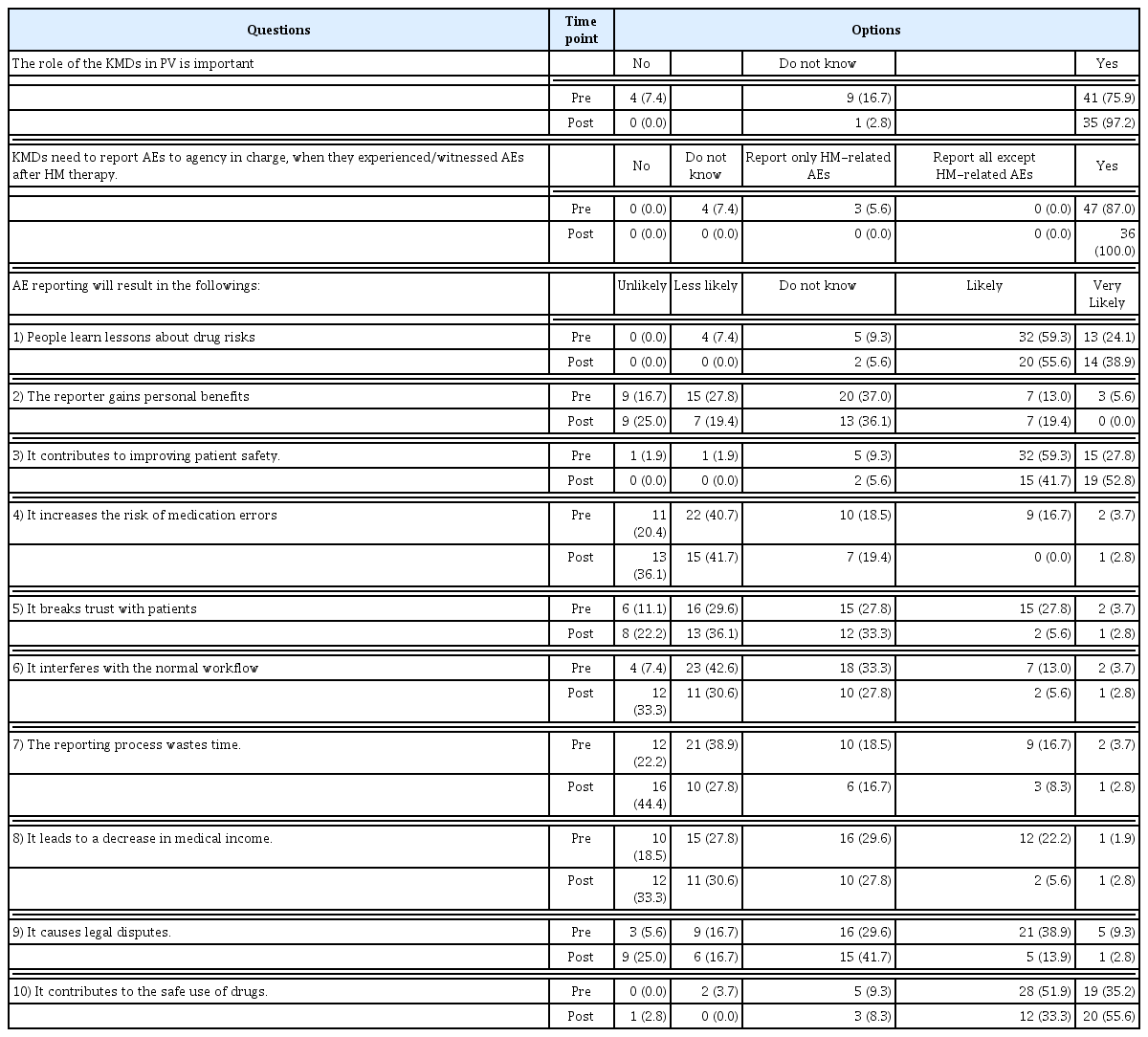References
1. Korea Institute of Drug Safety & Risk Management. Drug Safety Information. KIDS Webpage [cited 2020 12 Jan]; Available from:
https://www.drugsafe.or.kr/
.
2. Lopez-Gonzalez E, Herdeiro MT, Figueiras A. Determinants of under-reporting of adverse drug reactions: a systematic review. Drug Saf 2009;32(1):19–31.
3. Shetti S, Kumar CD, Sriwastava NK, Sharma IP. Pharmacovigilance of herbal medicines: Current state and future directions. Pharmacogn Mag 2011;7(25):69–73.
4. Inman WH. Attitudes to adverse drug reaction reporting. Br J Clin Pharmacol 1996;41(5):434–5.
5. Hartman J, Härmark L, van Puijenbroek E. A global view of undergraduate education in pharmacovigilance. Eur J Clin Pharmacol 2017;73(7):891–9.
6. Beckmann J, Hagemann U, Bahri P, Bate A, Boyd IW, Dal Pan GJ, et al. Teaching pharmacovigilance: the WHO-ISoP core elements of a comprehensive modular curriculum. Drug Saf 2014;37(10):743–59.
7. van Eekeren R, Rolfes L, Koster AS, Magro L, Parthasarathi G, Al Ramimmy H, et al. What future healthcare professionals need to know about pharmacovigilance: introduction of the WHO PV core curriculum for university teaching with focus on clinical aspects. Drug Saf 2018;41(11):1003–11.
9. Schutte T, Tichelaar J, Reumerman MO, van Eekeren R, Rolfes L, van Puijenbroek EP, et al. Feasibility and educational value of a student-run pharmacovigilance programme: a prospective cohort study. Drug Saf 2017;40(5):409–18.
10. Schutte T, Tichelaar J, Reumerman MO, van Eekeren R, Rissmann R, Kramers C, et al. Pharmacovigilance skills, knowledge and attitudes in our future doctors–A nationwide study in the Netherlands. Basic Clin Pharmacol 2017;120(5):475–81.
11. Choi N-K, Kwon H-B, Lee A-Y, Park B-J. A Survey on Attitudes and Awareness of Physicians and Pharmacists Regarding Spontaneous Reporting System and Experience for Adverse Drug Events in Goyang-si. JPERM 2008;1:44–52.
12. Teong C-H, Jeong J-S, Park K-H, Lee D-W, Park S-C. Medical Staff’s Attitude towards Adverse Drug Reaction in the Dongguk University Gyeongju Hospital. Korean J Fam Pract 2015;5(1):25–33.
13. Braun V, Clarke V. Using thematic analysis in psychology. Qual Res Psychol 2006;3(2):77–101.
15. Jung S-Y, Choi N-K, Lee J, Park B-J. Use of big data for drug safety monitoring and decision making. J Korean Med Assoc 2014;57(5):391–7.
16. Alomar MJ. Factors affecting the development of adverse drug reactions. Saudi Pharma J 2014;22(2):83–94.
18. Park B-J. Status and Improvement Plan of Patient Safety Management System Related to Pharmaceutical Products. HIRA Policy Trend 2014;8(5):16–26.
19. Park J-W. Past, Present, and Future of Korean Regional Drug Safety Center. JPERM 2018;10:43–8.
21. APEC Harmonization Center. 2015 AHC Activity Report 2016;:28–31.
22. Woo Y-j, Chung S-y, Park B-J. Current Status of Spontaneous Adverse Reactions Reporting System on Herbal Medicine in China, Japan, Korea and WHO. J Int Korean Med 2014;35(2):111–8.
23. Woo Y-j, Chung S-y, Park B-J. Necessity of Reporting on Herbal Medicine Adverse Event and Introduction of Reporting Method. J Int Korean Med 2014;Oct. :174–9.
24. Shaw D, Graeme L, Pierre D, Elizabeth W, Kelvin C. Pharmacovigilance of herbal medicine. J Ethnopharmacol 2012;140(3):513–8.
26. Wechwithan S, Suwankesawong W, Sornsrivichai V, McNeil EB, Jiraphongsa C, Chongsuvivatwong V. Signal detection for Thai traditional medicine: examination of national pharmacovigilance data using reporting odds ratio and reported population attributable risk. Regul Toxicol Pharmacol 2014;70(1):407–12.
27. Fahim SM, Mishuk AU, Cheng N, Hansen R, Calderon AI, Qian J. Adverse event reporting patterns of concomitant botanical dietary supplements with CYP3A4 interactive & CYP3A4 non-interactive anticancer drugs in the U.S. Food and Drug Administration Adverse Event Reporting System (FAERS). Expert Opin Drug Saf 2019;18(2):145–52.
28. Li H, Deng J, Yue Z, Zhang Y, Sun H. Detecting drug-herbal interaction using a spontaneous reporting system database: an example with benzylpenicillin and qingkailing injection. Eur J Clin Pharmacol 2015;71(9):1139–45.
29. Kwon Y-J, Jo W-K, Han C-H. Status of Herbal-drug-associated Adverse Drug Reactions Voluntarily Reported by EMR. J Int Korean Med 2012;33(4):485–97.
30. Kim M, Han C-H. Analysis of Herbal-drug-associated Adverse Drug Reactions Using Data from Spontaneous Reporting System in Electronic Medical Records. J Korean Med 2015;36(1):45–60.
31. Lee SH, Song BW, Choi HJ, Kim EY. The Analysis of Herbal Medicine-Associated Adverse Drug Reactions Spontaneously Reported in a Korean Medicine Hospital. J Kor Soc Health-syst Pharm 2017;34(2):183–99.
32. Cho J-H, Oh D-S, Hong S-H, Ko H, Lee N-H, Park S-E, et al. A nationwide study of the incidence rate of herb-induced liver injury in Korea. Arch Toxicol 2017;91(12):4009–15.
33. Kim M, Han C-H. Adverse drug reactions in Korean herbal medicine: A prospective cohort study. Eur J Integr Med 2017;9:103–9.
34. Woo Y, Hyun MK. Safety of herbal medicine for elderly patients with chronic disease in the Republic of Korea. Eur J Integr Med 2019;30:100934.
35. Elkalmi RM, Hassali MA, Ibrahim MIM, Widodo RT, Efan QMA, Hadi MA. Pharmacy Students’ Knowledge and Perceptions About Pharmacovigilance in Malaysian Public Universities. Am J Pharm Educ 2011;75(5):96.
36. Kim HJ, Hwang SY. Impact of Safety Climate Perception and Barriers to Adverse Drug Reaction Reporting on Clinical Nurses’ Monitoring Practice for Adverse Drug Reactions. Korean J Adult Nurs 2018;30(2):115–25.
37. Kyung EJ, Rew JH, Oh M, Kim EY. A Survey on Attitude and Awareness of Health-Care Professionals Regarding Pharmacovigilance System and Experience for Adverse Drug Reaction (ADR) from a Single University Hospital. Korean K Clin Pharm 2013;23(3):256–68.
38. De Smet PA. An introduction to herbal pharmacoepidemiology. J Ethnopharmacol 1993;38(2–3):189–95.
39. Farah M. Guidelines for herbal ATC classification Uppsala Monitoring Centre. Uppsala: 2004.
40. Farah M. Herbal ATC index Uppsala. Uppsala Monitoring Centre: 2004.
44. Lesar TS, Briceland L, Stein DS. Factors Related to Errors in Medication Prescribing. JAMA 1997;277(4):312–7.
45. Gavaza P, Bui B. Pharmacy students’ attitudes toward reporting serious adverse drug events. Am J Pharm Educ 2012;76(10):194.
46. Gerritsen R, Faddegon H, Dijkers F, van Grootheest K, van Puijenbroek E. Effectiveness of pharmacovigilance training of General Practitioners. Drug Saf 2011;34(9):755–62.
47. Reumerman M, Tichelaar J, Piersma B, Richir MC, van Agtmael MA. Urgent need to modernize pharmacovigilance education in healthcare curricula: review of the literature. Eur J Clin Pharmacol 2018;74(10):1235–48.
